#MAJOR J.A. McINTOSH
Text
Bucorvus
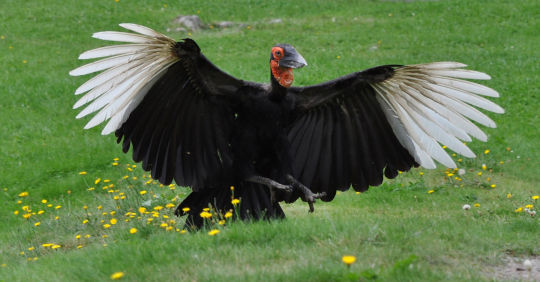
Southern Ground Hornbill by Neil McIntosh, CC BY 2.0
Etymology: Hornbill Crow
First Described By: Lesson, 1830
Classification: Dinosauromorpha, Dinosauriformes, Dracohors, Dinosauria, Saurischia, Eusaurischia, Theropoda, Neotheropoda, Averostra, Tetanurae, Orionides, Avetheropoda, Coelurosauria, Tyrannoraptora, Maniraptoromorpha, Maniraptoriformes, Maniraptora, Pennaraptora, Paraves, Eumaniraptora, Averaptora, Avialae, Euavialae, Avebrevicauda, Pygostaylia, Ornithothoraces, Euornithes, Ornithuromorpha, Ornithurae, Neornithes, Neognathae, Neoaves, Inopinaves, Telluraves, Afroaves, Coraciimorphae, Cavitaves, Eucavitaves, Picocoraciae, Bucerotiformes, Buceroti, Bucorvidae
Referred Species: B. brailloni, B. leadbeateri (Southern Ground Hornbill), B. abyssinicus (Abyssinian/Northern Ground Hornbill)
Status: Extinct - Extant, Vulnerable
Time and Place: From about 12 million years ago, in the Serravallian of the Miocene, through today


Ground Hornbills are known from across the entire African continent

Physical Description: Ground Hornbills are truly impressive living dinosaurs, large in body and bulky in form. They can reach up to 100 centimeters in length, weighing as much as 6 kilograms. They are black over most of their bodies (leading to their being named for crows and ravens, which they are not closely related to at all), with grey legs and grey bills. They also have grey crests on the tops of their heads. Their heads feature bright coloration which is distinguished from the rest of the body - red patches, blue patches, yellow bits, and wattles, which vary from species to species. The undersides of their wings are white, and they have short and thin tails. Called hornbills for their very large, pointed beaks, these bills make up a major chunk of their heads. They also, interestingly enough, have eyelashes on their eyes to aid in protecting them. The juveniles are somewhat brown, and they become more black in color as they age.
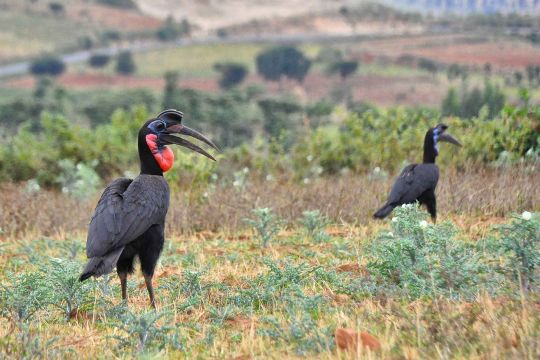
Northern Ground Hornbills by Rod Waddington, CC BY-SA 2.0
Diet: Ground Hornbills primarily feed upon arthropods such as insects, spiders, and scorpions. They also feed upon other invertebrates like snails, and larger prey such as snakes, lizards, small mammals, and carrion. Though they have been recorded feeding upon berries, they are primarily carnivorous.
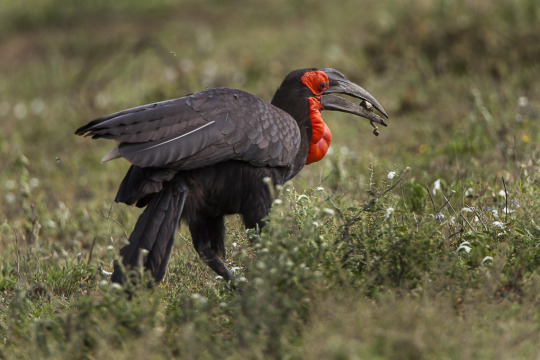
Southern Ground Hornbill by Francesco Veronesi, CC BY-SA 2.0
Behavior: Ground Hornbills are extremely fascinating creatures, able to fly but spending most of their time on the ground searching for sources of food. They will move slowly and carefully, searching around for prey that then is picked up with their large bill, very carefully and in a picky fashion from the ground. They forage in small groups - with a mate, or with their offspring. They rarely gather in large groups, usually only when food is especially abundant. They’ll even dig into the ground or poop looking for food. When large prey is found, groups will gather and attack it together, dismembering it as a team. These are extremely vocal birds, making low-pitched hoots at each other often at two different pitches. They will make softer hoots when snuggling with each other, and deep alarm grunts. They are often known to call for long periods of time. They do not migrate, but do wander about; juveniles will stay where their parents lived for many years.
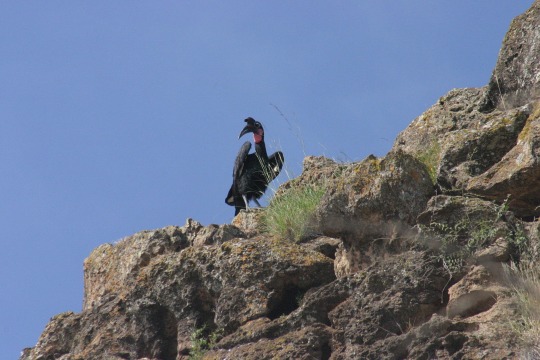
Northern Ground Hornbill by Sakari A. Maaranen, CC BY 3.0
The Ground Hornbills are cooperative breeders - the dominant pair will be assisted by juvenile and younger adult helpers, all defending the nesting territory fiercely. Males will prepare their nests in large tree cavities, sometimes in rock holes or baskets - they will line the hole with dry leaves, and not seal the entrance. Two to three eggs are laid and incubated for two months by the dominant female of the group. Upon hatching, the group members will feed the babies together, but usually the second or third eggs don’t survive - either the eggs don’t hatch, or the chicks starve to death. The chicks stay in the nest for three more months, and the juveniles stick with their families for a little while after hatching. They tend to reach sexual maturity between six and seven, but they don’t usually breed for the first time until later. They also tend to breed only once every three years - a rarity for birds. The birds can live for a very long time - in captivity, they’ve been seen living for up to 40 years.
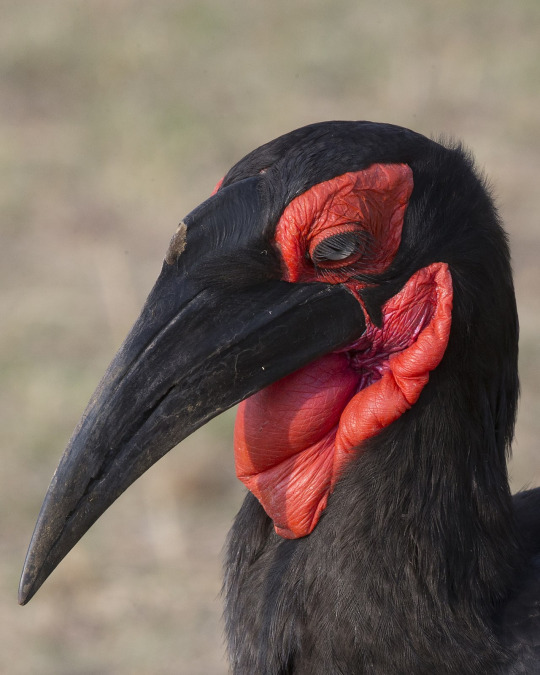
Southern Ground Hornbill by Lip Kee, CC BY-SA 2.0
Ecosystem: Ground Hornbills live in a variety of habitats, across woodland and savanna, as well as grassland patches. The Southern Ground Hornbills live in more moist habitats than the Northern Ground Hornbills. They are often fed upon by large carnivores such as leopards, and can be a host for a wide variety of parasites and diseases.

Northern Ground Hornbill by Bernard Dupont, CC BY-SA 2.0
Other: All living Ground Hornbills are recorded as being vulnerable to extinction at this time. Despite being extremely widespread, they are sparse across their range. This sparseness makes it harder for them to find others of their species and mate with them. They are often hunted and killed, or even murdered as a bringer of bad luck in some cultures. Ground Hornbills also break window panes and are killed for that, in addition to being killed for being a harbinger of drought. Habitat loss also greatly contributes to their decline in population. They do live in several national parks, and there are conservation efforts to aid in its reproduction, using the abandoned eggs to raise more of the birds. Reintroduction, however, is more difficult than anticipated.
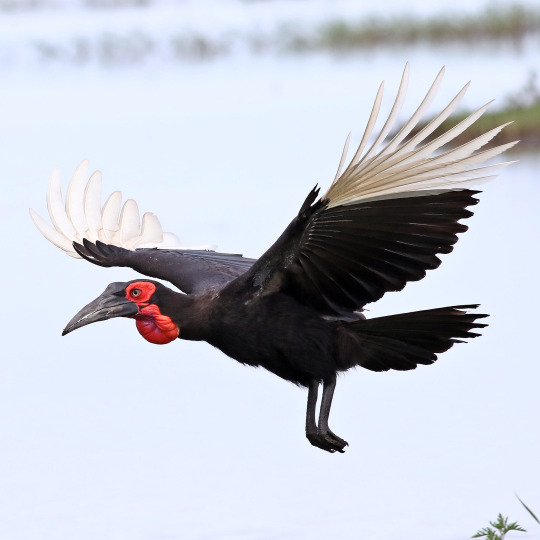
Southern Ground Hornbill by Derek Keats, CC BY 2.0
Species Differences: The Northern Ground-Hornbill is known from Central Africa, and features blue patches on its face with a yellow bit in the front. Males have red additions to their throat wattles. The Southern Ground-Hornbill, on the other hand, is all red, with no yellow or blue to be found. They are also found in southern Africa. In addition to all of this, the Northern Ground-Hornbill is somewhat lighter in weight than the Southern Ground-Hornbill. The extinct species, B. brailloni, was from much more north - in Morocco - and was much older, as well as a little smaller, than its living relatives.

Northern Ground Hornbill by Noel Reynolds, CC BY 2.0
~ By Meig Dickson
Sources under the Cut
Gill, Frank; Donsker, David, eds. (2019). "Mousebirds, Cuckoo Roller, trogons, hoopoes, hornbills". World Bird List Version 9.2. International Ornithologists' Union. Retrieved 23 July 2019.
Gonzalez, J.-C.T.; Sheldon, B.C.; Collar, N.J.; Tobias, J.A. (2013). "A comprehensive molecular phylogeny for the hornbills (Aves: Bucerotidae)". Molecular Phylogenetics and Evolution. 67 (2): 468–483.
Jobling, James A. (2010). The Helm Dictionary of Scientific Bird Names. London: Christopher Helm. p. 80.
Kemp, A. C. 1995. The Hornbills. Oxford University Press, Oxford.
Kemp, A.C. & Boesman, P. (2019). Northern Ground-hornbill (Bucorvus abyssinicus). In: del Hoyo, J., Elliott, A., Sargatal, J., Christie, D.A. & de Juana, E. (eds.). Handbook of the Birds of the World Alive. Lynx Edicions, Barcelona.
Kemp, A.C. & Boesman, P. (2019). Southern Ground-hornbill (Bucorvus leadbeateri). In: del Hoyo, J., Elliott, A., Sargatal, J., Christie, D.A. & de Juana, E. (eds.). Handbook of the Birds of the World Alive. Lynx Edicions, Barcelona.
Kinnaird Margaret F. and O‘Brien, Timothy G.; The Ecology and Conservation of Asian Hornbills: Farmers of the Forest; pp. 20-23.
Lesson, René (1830). Traité d'Ornithologie, ou Tableau Méthodique (in French). Paris: F.G. Levrault. p. 256
Peters, James Lee, ed. (1945). Check-list of Birds of the World. Volume 5. Cambridge, Massachusetts: Harvard University Press. p. 272.
Skutch; Alexander Frank (author) and Gardner, Dana (illustrator) Helpers at birds' nests : a worldwide survey of cooperative breeding and related behavior pp. 69-71. Published 1987 by University of Iowa Press.
Wasser, D. E. and Sherman, P.W.; “Avian longevities and their interpretation under evolutionary theories of senescence” in Journal of Zoology 2 November 2009
#Bucorvus#Ground Hornbill#Bird#Dinosaur#Hornbill#Birblr#Factfile#Bucorvus brailloni#Bucorvus leadbeateri#Bucorvus abyssinicus#Southern Ground Hornbill#Palaeoblr#Abyssinian Ground Hornbill#Northern Ground Hornbill#Afroavian#Terrestrial Tuesday#Carnivore#Africa#Quaternary#Neogene#paleontology#prehistory#prehistoric life#dinosaurs#biology#a dinosaur a day#a-dinosaur-a-day#dinosaur of the day#dinosaur-of-the-day#science
120 notes
·
View notes
Text
CONFIDENTIAL
WAR DIARY
-OF-
18th CANADIAN BATTALION – 2nd CANADIAN DIVISION
From 1st December to 31th December 1917
Volume 28
With appendicix “A”
Place Date Hour Summary of Events and Information Vancouver Road T28.a.5.2 1 Battalion in support area at Vancouver Rd. Situation quiet, nothing unusual occurred. Major J.R. Richardson rejoined Battalion from England. 5 o.r.s admitted to hospital.
2 Position as shown yesterday. Wiring party of 2 Officers and 30 o.r.s put out 60 yds of single apron wire in front for trench to T.24.c.90.50 to T.24.c.80.70. 2 o.r.s arrived and reinforcement.
Map 36 C. 1/20000 Winnipeg Road 3 18th Battalion relieved 19th Battalion in front line Acheville Sector. Relief completed at dusk without casualty. 58 o.r.s arrived as reinforcements. 7 o.r.s joined from hospital.
4 Battalion in front line. Wiring parties put out barbed wire in front of trenches during night. Nothing unusual occurred.
5 Positions same. Wiring parties out at night and fatigue parties improving trenches. 2 o.r.s returned from hospital.
6 Situation quiet. Considerable aeroplane activity on both sides patrolling the lines. 50 o.r.s arrived as reinforcements. Lieut. C.B. Oglesby attached to 4th Can. Trench Mortar By. 1 o.r. wounded.
7 Situation unchanged. Enemy working parties observed by our observers working on Rouvroy Trench. 2 o.r.s admitted to hospital. 1 o.r. wounded.
8 Position same. Considerable enemy artillery activity on rear country throughout the day. 2 o.r.s returned form Base.
9 Enemy working parties seen by observers working on support trenches, and artillery notified. 2 o.r.s attached to Brigade as messengers.
Map Rouvroy 1/10000 10 Battalion relieved in front line by the 19th Battalion. 18th Battalion moved back into support area. Bn. HQ being in Vancouver Road at T.28.a.5.2. A coy in New Brunswick Trench. B coy in Ottawa-Hudson and C Coy Canada. D New Brunswick. 1 o.r. wounded.
Vancouver + New Brunswick 11 Battalion in Support Area. Position as shown yesterday. Polling for Canadian Election Commenced to-day under the supervision of Capt. C.P. Laing. 7 o.r.s admitted to hospital.
12 Continuation of voting. Working parties rejoined + building up of trenches. 76 o.r.s arrived as reinforcements. 8 o.r.s rejoined from hospital.
Relief 13 Battalion relieved in support area by the 20th Battalion. 18th Battalion upon being relieved moved back to Suburban Camp near Viller-au-Bois. 2 o.r.s returned from hospital.
14 Company inspections and parades for voting.
15 Bath parades and inspection kit and equipment by Company Commanders. Lieut. R.C. Sheridan rejoined from hospital.
16 10.30 a.m. Battalion paraded for Divine Service, after which the men were dismissed for the day.
Suburban Camp 17 Parades as per syllabus attached. 18 Parades as per syllabus attached. 4 o.r.s proceeded to England for Officers Course.
19 Battalion moved by to [sic] Febvin-Palfart (Rest Area) being conveyed by motor lorries. Battalion transport moving independently, breaking the journey at Cauchin Legal. See O.O. attached.
Fabrin Palfart 20 Battalion billeted in Barns and homes round the village. Today was spent settling down to billets.
21 Parades as per syllabus attached. 3 o.r.s admitted to hospital. 3 N.C.O.s attached to Battalion from training school for instructional purposes.
22 Parades as per syllabus attached. Lieut. H.N. Bawden rejoined Battalion from Training School.
23 Battalion parade for Devine Service. Lt. Col. L.E. Jones proceeded on leave to England. Major J.A. McIntosh taking over Command of the Battalion.
24 Parades as per syllabus attached. 3 o.r.s rejoined from hospital.
25 Christmas Day. No training today. A Christmas Dinner of Turkeys and Porks was arranged for all men of the Battalion, and everything was done by the Officers to make the men comfortable for this occasion.
26 Company inspections by Company Commanders, and checking of Equipment and Kit.
27 9.15 Battalion paraded in full marching order for route march. (see syllabus attached) 10 o.r.s. arrived as reinforcements.
28 Parade and training as per syllabus attached. 2 o.r.s returned from hospital.
29 Parade and training as per syllabus attached. 30 Lieut. A.B. Yeo arrived as reinforcement. 3 o.r.s admitted to hospital. 2 o.r.s returned from hospital.
31 [No entry.]
War Diary
Appnedicis
War Diary of the 18th Battalion: December 1917 CONFIDENTIAL WAR DIARY -OF- 18th CANADIAN BATTALION – 2nd CANADIAN DIVISION From 1st December to 31th December 1917…
#19th Battalion C.E.F.#20th Battalion C.E.F.#4th Trench Mortar Battery#ACHEVILLE#barns and houses#Canada Trench#Christmas Day#Christmas Dinner#Couchin Legal#Divine Service#election#Febrin - Palfavl Rest Area#full marching order#Lieut. A.B. Yeo#Lieut. C.E. OGLESBY#Lieut. Col. L.E. Jones#LIEUT. H.N. BAWDEN#Lieut. R.C. Sheridan#MAJOR J.A. McINTOSH#Major J.J. Richardson#Newbrunswick Trench#Ottawa - Hudson Trench#route march#ROUVROY#single apron wire#Suburban Camp#Vancouver Road#Villers-Au-Bois#voting#Winnipeg Road
0 notes
Text
...and no battalion has a more glorious record than our good old 18th.
…and no battalion has a more glorious record than our good old 18th.
Detail of the 18th Battalion April 1915 Nominal Roll showing the original officers.
On April 10, 1919 two news stories about the 18th Battalion were published on page three in the Border Cities Star. One story was about the past, told of a traitor in the 18th who “surrendered” to the Germans in July 1918 while the Battalion was stationed in the Telegraph Hill area in the Arras Sector. The other…
View On WordPress
#Border Cities Star#CAPT C.P. LAING#Captain Arthur Carlisle#Captain H.G. Emery#Lieut. Col. L.E. Jones#LIEUT. D. St.J WIGLE#LIEUT. J.S. BELL#LIEUT. R.G. ELLIOT#Lt. Col. E.S. Wigle#MAJOR A.C. PRINCE#MAJOR J.A. McINTOSH#Major W.J. Baxter#Nominal Roll#repatriaion
0 notes
Text
One of the Best Looking Men: Lieut. Clarke at St. Eloi
One of the Best Looking Men: Lieut. Clarke at St. Eloi
18th Battalion Association[i]
Windsor and Detroit Branch
*MEMORIES*[ii]
At one of our Reunion Dinners some years ago, one of he speakers mentioned Lieut. John Clarke[iii], but placed him in the wrong Company. Lieut. Clarke was the Officer in charge of Thirteen Platoon. The other “D” Company Officers were Lieut’s Ambery, McIntosh, and Dillon. Lieut. Clarke, or Johnny Clarke, as most of us called…
View On WordPress
#"D" Coy#33rd Battalion#CAPT. S.M. LOGHRIN#LIEUT. DILLON#LIEUT. J.A. MCINTOSH#Lieut. J.A.G. Clarke#Lt. Ambery#MAJOR EMMERTON#No Man&039;s Land#St. Eloi#Windsor Ontario#Wounded in Action
0 notes
Text
CONFIDENTIAL
WAR DIARY
-OF-
18th CANADIAN BATTALION – 2nd CANADIAN DIVISION
From 1st June to 31th June 1917
Volume 22
With appendicies 1-3
Place Date Hour Summary of Events and Information 1 Map reference WILLERVAL 1/20,000
Battalion in Brigade Support with H.Qrs at T.27.d.3.5.
During the night Battalion was relieved by 15th Canadian Battalion and the whole of the 4th Brigade moved back to RIDGE Line with H.Qrs at ZIVY CAVE.
2 12 noon. Battalion relieved by the 7th Canadian Battalion and moved back into Reserve camp near NEUVILLE-ST-VAST. Lieut. H.N. Bawden admitted to hospital (sick). 3 10. a.m. 4th Canadian Infantry Brigade relieved the 1st Canadian Infantry Brigade. 18th Battalion marched back to billets in BARLIN[i]. 6 o.rs rejoined from hospital. 2 instructors from Canadian Corps Gymnastic Staff attached to Battalion for instructional purposes. BARLIN 4 Battalion resting and settling down in billets. “ 5 Battalion Pay and Bath parades. 9 o.rs returned from hospital. “ 6 Clothing parades and completion of Bath parades. Lieut. C.H. Biscoe and 42 o.rs arrived as reinforcements, many of them old men rejoining.[ii] “ 7 Inspection of Companies by Company Commanders. Syllabus of training to be carried out (attached). 7 o.rs arrived as reinforcements. “ 8[iii] Morning
Afternoon
Company parades and training. Specialists training under qualified instructors.
Recreational training and sports. 2 o.rs admitted to hospital.
“ 9 Morning
Afternoon
Physical training under special instructors.
Recreational training.
“ 10 9. a.m. Church parade. Remainder to day spent in recreation. 3 o.rs admitted to hospital. “ 11 Morning Training according to syllabus. Afternoon, recreational training. Lieut. L.A. Bissell and 18 o.rs arrived as reinforcements. “ 12 Morning “C” Company on specialist training under specialists Officers. “A. B. & D” coys training according to syllabus. Lieut. H.N. Bawden and 15 o.rs returned from hospital.
A Horse show was held by Brigade at which we gained 1 second and 2 third prizes.
“ 13 Morning “B” Company at ranges on Musketry instruction. Special training by R.S.M. Price[iv] of N.C.Os. 52 o.rs arrived as reinforcements. 3 o.rs returned from hospital. “ 14 Battalion training to according to syllabus. 3 o.rs accidentally wounded. “ 15[v] Battalion sports held at RUITZ. Races, Tug of War, Football and Wrestling during the day and a concert in the evening by the Battalion Band. “ 16 Morning Training according to syllabus. 48 o.rs arrived as reinforcements. 5 o.rs returned from hospital. “ 17 9.a.m. Church parade. “C” Company on Musketry at ranges. Afternoon being spent in recreational exercise. Battalion Football team played and beat the 4th M.G. coy in competion [sic] for the Divisional Championship. “ 18 9.15.a.m. Battalion parade to Brigade sports. Battalion Football team making a draw with 20th Battalion for Brigade Championship. Prizes were presented at the close by Brig-General R. Rennie, C.M.G., V.O., D.S.O. “ 19 Morning “A” and “D” companies on special training under Physical instructors. “B” and “C” on usual syllabus training. “ 20 “ Syllabus training. 11.15.a.m. Battalion parade. 21 “ “D” Company on Musketry at Ranges. “C” Company on Specialist training, remainder of Battalion carrying on with usual syllabus of training. 5 o.rs admitted to hospital. 22 Training according to syllabus. Lt.-Col. L.E. Jones proceeded on leave. Major J.A. McIntosh assumed command of the Battalion. 23 Company bath parades in morning. Voluntary parade to Divisional sports in the afternoon, Lieut. W.S. Caldwell[vi], J.G. Doherty, J.D. Parsons arrived as reinforcements. 24 9.a.m. Church parade. 3 o.rs returned from hospital. Lieut. J. M. Fisher returned from leave. 25 Parade of all casuals for Musketry training at ranges. Company training as per syllabus. 1 o.r. admitted to hospital (injured). 26 Company inspections. Platoon training in attack. Physical training and Bayonet fighting. Major W.J. Gander and 4 o.rs admitted to hospital (sick). 27 Commanding Officer’s inspection of Companies and Units. 3 o.rs returned from hospital. Capt. J.S. Bell rejoined the Battalion from Divisional school. 28 11.a.m. Battalion inspected by G.O.C. 2nd Canadian Division. Battalion paraded in full marching order at 10 a.m. and was highly complimented on their smart appearance. 29 Platoon training in attack and Bayonet fighting. Lieuts. H.L. Mitchell and H.B. Johnson arrived as reinforcements. 30 Company inspections. Close order and Arm drill. Battalion parade at 11.00 a.m. 2 o.rs admitted to hospital.
53730 L/Sgt. Sifton E.W. (Killed in Action 9.4.17) Awarded VICTORIA CROSS. “For most conspicuous bravery and devotion to duty. During the attack in enemy trenches Sjt. Sifton’s company was held up by machine gun fire which inflicted many casualties. Having located the gun he charged it single-handed, killing all the crew. A small enemy party advanced down the trench, but he succeeded in keeping these off till our men had gained the position. He was killed just as he returned with the second man.In carrying out this gallant act he was killed, but his conspicuous valour undoubtedly saved many lives and contributed largely to the success of the operation.”
Appendix 1
18TH (WESTERON ONTARIO) CANADIAN BATTALION.
SYLLABUS OF TRAINING.
MUSKETRY COURSE
Instruction on Aiming and Trigger Pressing 2 hours.
Instruction in indication and recognition of Targets 2 hours
On the Range 8 hours.
(Practice in 1 and 2 to be carried on my units not actually firing.)
Lieutenant
Actg/Adjt. 18th (Western Ontario) Canadian Battalion
5.6.17.
18TH (WESTERON ONTARIO) CANADIAN BATTALION.
SYLLABUS OF TRAINING – 3 WEEKS
_ _ _ _ _ _ _ _ _ _ _ _ _ _ _ _ _ _ _
Tuesday 5.6.17
1ST WEEK
Organization – Drill and Discipline 4 days
Musketry – 1 day
Brigade Route March 1 day
Each Day – Mornings
Gas helmet drill, saluting etc. 1 hour
Physical Training and Bayonet Fighting 1 hour
Squad and Platoon Drill 1 hour
Arm drill ½ hour
At disposal of Platoon Commanders ½ hour
Afternoons
Training of Specialists – 2 hours per day.
2ND WEEK
Platoon Training 4 days.
Musketry – 1 day
Brigade Route March 1 day
For the week – Mornings
Close order drill 2 hours
Physical Training and Games 2 hours
Extended order Drill 4 hour
The value of the different weapons and their independence. 1 hour
Formation of Platoon for Attack 1 hour
The Platoon in the Attack – open warfare 4 hours
The Platoon in Trench Attack 2 Hours
Afternoons
Training of Specialists – 2 hours per day.
3RD WEEK
Company Training 4 days.
Musketry – 1 day
Brigade Route March 1 day
For the week – Mornings
Close order drill 2 hours
Physical Training and Games 2 hours
The Attack by stages as a Drill 6 hours
1st Stage – Artillery Formation.
2nd Stage – Extension into lines.
3rd Stage – Building up a Firing Line.
4th Stage – The Assualt.
5th Stage Consolidation and Protection.
Tactical exercise on new ground involving the above 3 hours
The Trench Attack 3 hours
Afternoons
Training of Specialists – 2 hours per day.
Appendix 2
18TH (WESTERON ONTARIO) CANADIAN BATTALION.
The Battalion Sports will be held on Friday June 15th at the Y.M.C.A. Grounds RUITZ, at 3.00 p.m.
The following events will be staged:
100 yards race
220 yards race
440 yards race (obstacle)
1 Mile Race.
Boat Race.
100 Yards Band Race.
3 Legged Race.
Sack Race.
Long Jump (Standing)
High Jump
Horse-back Wrestling.
Mule Race.
Tug-of-War (8 men per team)
Blind-fold Respirator Race.
Entries for the 100 yards, 220 yards and Long Jump are limited to 4 per Company.
Entries for various events to be handed in to Battalion Orderly Room by 12.00 noon June 14th.
Battalion Football Championship will be decided, followed by a Concert.
Officers are earnestly request to make inquiries among their Companies for singers and entertainers for this Concert.
Special Feature
Tug-of-War between “Q.M. Details” (Captained by Bandmaster G.W. Thomas[vii]) and “Transport Section” (Captained by Sgt. H. Green) will be decided as the result of challenge by the letter.
PROGRAMME
OF
4TH CANADIAN INFANTRY BRIGADE SPORTS
CHATEAU GROUNDS COUPIGNY
TIME EVENT REMARKS 1 10.00 a.m. OUTDOOR BASEBALL FINAL 2 11:30 a.m. FOOTBALL FINAL 3 11:30 a.m. OFFICERS INDOOR BASEBALL FINAL AFTERNOON 4 02:00:00 100 YARD DASH (OFFICERS) 5 02:15:00 100 YARD DASH (OTHER RANKS) 6 02:30:00 220 YARD DASH (OTHER RANKS) 7 02:40:00 1 MILE RELAY (OTHER RANKS) 8 02:50:00 OFFICERS RELAY RACE (440 YARDS) 9 03:00:00 HIGH JUMP – FINALS (OPEN) 10 03:00:00 RUNNING ROAD JUMP (OPEN) 11 03:15:00 TUG OF WAR 12 03:30:00 OBSTACLE RACE (OPEN) 13 03:30:00 SACK RACE 14 03:30:00 THREE LEGGED RACE 15 03:45:00 BAND RACE 16 04:00:00 BOAT RACE 17 04:00:00 BLINDFOLD RACE 18 04:15:00 MULE RACE 19 04:30:00 HORSEBACK WRESTLING 20 04:45:00 BOXING – WEIGHT 12O Pounds BOXING – WEIGHT 135 Pounds BOXING – WEIGHT 145 Pounds BOXING – WEIGHT 160 Pounds and over 05:45:00 OFFICERS MOUNTS JUMPING 06:00:00 PRESENTATION of PRIZES by BRIG-GENERAL R. RENNIE C.M.G., M.V.O., D.S.O.
OFFICIALS HON. MARSHALL OF THE FIELD BRIG-GENERAL R. RENNIE C.M.G., M.V.O., D.S.O. HON. JUDGES Lieut.-Col. L.H. MILLEN HON JUDGES Lieut.-Col. H.V. RORKE D.S.O. HON JUDGES Lieut.-Col. L.E. JONES HON JUDGES Lieut.-Col. T.F. ELMITT JUDGES Major D.E. MACINTYRE, D.S.O., M.C. JUDGES Major H.E. HATCH JUDGES Major G.H. MUSGROVE JUDGES Major W. FORBES-MITCHELL, D.S.O. CLERK OF COURSE Major H.D. FEARMAN, D.S.O. STARTER Captain H.C. PATTERSON, Y.M.C.A. ASST. STARTER Captain MOORE, Y.M.C.A.[viii] TIMER (TRACK EVENTS) Captain R.N. JAGO SCORERS (FIELD EVENTS) Captain E.V. BENJAMIN, M.C. Lieut. A.P. CHRISTMAS SCORER (BOXING) Major C.E. SINCLAIR, M.C. ANNOUNCERS R.S.M. T.F. JORDAN, M.C., 21st Bn. R.S.M. J. COLLETT, 20th Bn.
[i] Barlin is a commune west of Lens approximately 15 kilometers.
[ii] The reference to “old men rejoining” is unclear but is probably alluding to men of the original draft of the Battalion who joined between October 1914 and March 1915 are returning to the Battalion after being wounded or ill and upon completion of their rest and refitting in England and in France.
[iii] On June 8, 1917 a SPECIAL ORDER was forwarded to all units. This order was a letter to the members of the Canadian Corps by Lieutenant-General Julian Byng saying “Goodbye” to the Corps.
[iv] The identity of this soldier has not been confirmed. Possibly Price, George: Service no. 928158.
[v] See Appendix 2.
[vi] Lt. Caldwell was one of the 18th Battalion “originals” and rose from the ranks. See his digitized service record for more information.
[vii] Soldier not identified at this time.
[viii] Soldier unknown at time of post.
War Diary of the 18th Battalion: June 1917 CONFIDENTIAL WAR DIARY -OF- 18th CANADIAN BATTALION – 2nd CANADIAN DIVISION From 1st June to 31th June 1917…
#20th Battalion C.E.F.#21st Battalion C.E.F.#4th Machine Gun Company#arms drill#BARLIN#bath parade#Battalion Band#Battalion Baseball Team#Battalion Sports#billets#Brigadier General Robert Rennie#Canadian Corps Gymnastic Staff#Capt. J.S. Bell#Church Parade#close order drill#concert#Divisional Championship#football#Horse Show#Lieut. C.H.Biscoe#Lieut. H.B. Johnson#Lieut. H.L. Mitchell#Lieut. J.D. Parsons#Lieut. J.G. Doherty#LIEUT. J.M. FISHER#Lieut. W.S. Caldwell#Lt.-Col. L.E. Jones#MAJOR J.A. McINTOSH#Major W.J. Gander#musketry instruction
0 notes